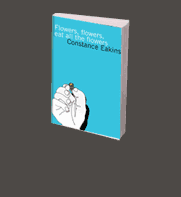Anzelmo, Francesco. “Gli orrori di Eakins,
amico degli Italiani, nel suo libro Il buio e il diavolo,” Critica
Letteraria Milenese 58:1 (1993): 42-53.
Ark, Thom. “Eakins’s Purgatorio,” The
Sewanee Purchase Review 23.2 (1972): 8-13.
Axelrod, Sam T. “Dreiser, The Rude
Violence of the Poor, and the Eakins Warchild,” Evergreen
State Review 31:2 (1998): 55-62.
Bartok, Roland. “Dolman Hardy:
Myth and/or Reason,” Bulletin of the New Orleans Constance
Eakins Society 12 (1961): 29-32.
Bazzle, J. Bradley. “The Monster from St.
Rose and the Thirty-Five Ugly Children To Which He Gave Succor,” The
Indiana Journal 102:3 (2007): 178-194.
Beckett, Wattson. “The Ecstatic Past: The
Nostalgic Impulse in Better Days Will Haunt You,” Eakins
Notes 23-24, (1990): 11-13.
Bickerton, Dwight. “Linguistic Outrage
in the Works of Constance Eakins,” International Journal
of North American Linguistics 43:1 (1999): 45-49.
Brentani, Eugene. “Eakins: The Man, The
Myth, The Monster,” Yale Journal of Comparative Literature 93
(2001): 132-186
Brown, Eric P. “Absurd America in the Novels
of Pynchon, Vonnegut, Eakins, and Boyle,” Modern Literature
Studies 16.1 (1978): 33-42.
Cadwallader, Morris. “Ecco Spiritus? Problems
of Interpretation in Eakins’s Latinate Cycle,” Poetics
Now 1.1/2 (1967): 85-102.
Dirkson, Louis A. “Hemingway, Fitzgerald,
and Eakins: A Comparative Diagnosis of Fear,” Literary
Fields 19:4 (1964): 43-50.
Doreander, Graydon L., et al. “Special
Section: A Discourse on Songs for Agata,” Contemporary
Poetry 31.1 (1992): 191-200.
Ernesto, Luisa. “A Cautious Approach to Private
Heresies,” The Journal of the Appalachian Mountain
Modern Language Association 26.4 (1966): 199-205.
Fazimodo, Gianfranco. “The Misunderstood
Glories of Flowers, Flowers, Eat More Flowers,” The
Lamp-Post of the Pacific-Union Society Constance Eakins Society 2
(1989).
Ferrer, Jorge. “The Slaying and
the Politics of Desire,” Constance Eakins Newsletter 42.4
(1997): 3-4.
Finland, Susan. “The Man With Holes in
His Head: Constance Eakins, a Post-Female Perspective,” New
Jersey Feminist Studies 13 (1978): 18-24.
Francalingua, Paul. “Saposcat, the Undefinable,” Eakinsalia:
The Journal of the Eakins Society 28 (1984). 311-321.
Gooden, Susan D. “Aporiosis: De Facto Legal
Immunity for World-Famous Authors,” Oklahoma University
Law Review 23:2 (1995): 363-369.
Greenleaf, Innila. “Eakins in Africa: Hegemony
and Its Enemy From the West,” International Perspectives
on Literature 1 (2002): 20-26.
Higuera, Jose. “The Silence of the Natives:
Eakins’s Beautiful Obsession,” Aesthetic Critique 12
(1991): 77-82.
Jelly-Schapiro. “Geographical Turpitudes
in The Slaughter and Beyond,” Berkeley Geographical
Studies 40:1 (2007).
Johannes, Astrid. “Military Intervention
in Constance Eakins’s Kamikaze Mountain,” The
Bulletin of Conflict Resolution 15.2 (1988): 35-39.
Johnson, Nathaniel J. “Cinematic Cyberverse:
Eakins in Film Today, Tomorrow, and Yesterday,” Film
and Literature 10 (2004): 84-88.
King, Daniel J. “The Man-Myth Behind Gashes,” Biographical
Studies Quarterly 53 (2005): 210-219.
Litvak, Boris. “Constance Imperatore: Eakins
and the Soviet New Wave,” Slavic Currents 5:4
(1982): 25-29.
Marolachakis, Stefan P. “Eakins: One of
Us? A New Postulation,” Greek Orthodox Today 13:1
(2002): 7-13.
Mason, Anthony. “Say Wha’? Crises
of Translation in the Literature of Constance Eakins,” TransLate/Form 4:4
(1995): 42-62.
Montoute, Ezechial. “Tropical Tangents
in Eakins’s Life and Literature, Being A Levelheaded Evaluation.” The
St. Lucia Journal of Critical Studies 12:2 (1990): 1-64.
Olaffsen, Henrik. “Stop Right There, Rummy-Guy!:
The American Vernacular in Bellow, Salinger, Eakins, and Mailer,” The
Swedish Review of American Literature 42:2 (1994): 13-33.
Orosco, J. R. “Precocious Boys: The Juvenelia
of Eliot, Eakins, Frost, and Kunitz,” Poetry Insider 5
(1974): 26-53.
Perry, Lord Adam. “The Price of Paradox
in the Short Fiction of Mr. Eakins,” Partisan 23
(1955): 20-32.
Plenel, Frédéric. “Quelle
invention!: Le panache de Constance Eakins, avant Nam, après
Corea,” Diacritiques 82:4 (2003): 34-52.
Quinn, Daniel. “Sacrificial Sacrifices
in Sacrament: A Notion,” Chicago Institute
of Critical Research Trimesterly, 34:2 (1987): 16-35.
Rich, Nathaniel. “Mending More than Canoes,” Continua 1
(2002), 43-46.
Rudey, Spencer and Amanda. “One Author’s
Quiet Influence on Regime Change in Kosovo,” The Los
Angeles Center of Policy Research Newsletter 3:6 (2008):
1-3.
Seaver, Janet. “Eakins and Eating: Salad
Days,” Food and Literature Digest 14 (1980): 4-13.
Swoboda, R. A. “The Devil and the Lightness?
Questioning the Ekphrastic Tendency in the Novels of Constance
Eakins,” Metropolitan Review 22 (1973): 54-75.
Throneberry, Martha. “A Nomadic Prayer
Before Death,” Saturnmagundabok 2 (1986): 42,
44.
Tonosaki, Miho. “Eakins and Japan: A Trans-Pacific
Quest,” Kyoto University Review and Letters 30:2/3
(1992): 44-50; 24-29.
Turner, Joseph Prince. “Mexican Migration
to the United States in the Works of Constance Eakins,” Global
Migration Review 32 (1999): 424-55.
Velazquez, Vivian. “The Secret Dramatic
World of Constance Eakins and One Dramaturg’s Excursions
Therein: A Polemic,” Tangents 42:3 (2000): 232-266.
Williams, F. R. “Eakins: The Soul of a
New Tomorrow,” Southern Forest Hill 8:3 (1975):
16-28.
Yourdon, David. “Cosmic Variabilities:
Eakins’s Dialogue with the Old Laws of New Physics,” The
Pittsburgh Journal of High Pressure Physics 21:3 (2006):
15-29.
|

